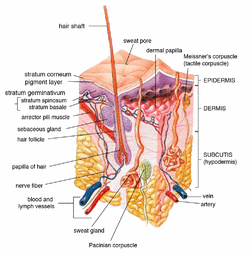| Subcutaneous tissue | |
|---|---|
 The hypodermis is the lower layer of skin shown in the diagram above. | |
| Details | |
| System | integumentary |
| Identifiers | |
| Latin | tela subcutanea[1] |
| MeSH | D040521 |
| TA98 | A16.0.03.001 |
| TA2 | 7083 |
| TH | H3.12.00.2.00001 |
| FMA | 9630 |
| Anatomical terminology | |
The Subcutaneous tissue (from Latin subcutaneous 'beneath the skin'), also called the hypodermis, hypoderm (from Greek 'beneath the skin'), subcutis, It is the lowermost layer of the integumentary system in vertebrates.[2] The types of cells found in the hypodermis are fibroblasts, adipose cells, and macrophages. The hypodermis is derived from the mesoderm, but unlike the dermis, it is not derived from the dermatome region of the mesoderm. In arthropods, the hypodermis is an epidermal layer of cells that secretes the chitinous cuticle. The term also refers to a layer of cells lying immediately below the epidermis of plants.
The hypodermis is beneath the dermis which is beneath the epidermis. It is used mainly for fat storage.
A layer of tissue lies immediately below the dermis of vertebrate skin.[3] It is often referred to as subcutaneous tissue. The hypodermis consists primarily of loose connective tissue. It contains larger blood vessels and nerves than those found in the dermis.
Structure
- Fibrous bands anchoring the skin to the deep fascia[4]
- Collagen and elastin fibers attaching it to the dermis[5]
- Fat is absent from the eyelids, clitoris, penis, much of pinna, and scrotum[1]
- Blood vessels on route to the dermis[6]
- Lymphatic vessels on route from the dermis[7]
- The glandular part of some sweat glands; mammary gland lie entirely within the subcutaneous tissue[8] (which are modified apocrine sweat glands)[9]
- Cutaneous nerves[7] and free endings
- Hair follicle roots
- Ruffini[10]:478 and Pacinian corpuscles
- Mast cells[11]
- Bursae, in the space overlying joints in order to facilitate smooth passage of overlying skin
- Fine, flat sheets of muscle, in certain locations, including the scalp, face, hand, nipple, and scrotum, called the panniculus carnosus
In some animals, such as whales and hibernating mammals, the hypodermis forms an important insulating layer and/or food store.
In some plants, the hypodermis is a layer of cells immediately below the epidermis of leaves. It is often mechanically strengthened, for example, in pine leaves, forming an extra protective layer or a water storage tissue.
Subcutaneous fat
Subcutaneous fat is the layer of subcutaneous tissue that is most widely distributed.[1] It is composed of adipocytes, which are grouped together in lobules separated by connective tissue.[5] The number of adipocytes varies among different areas of the body, while their size varies according to the body's nutritional state.[12] It acts as padding and as an energy reserve, as well as providing some minor thermoregulation via insulation.[10][5] Subcutaneous fat is found just beneath the skin, as opposed to visceral fat, which is found in the peritoneal cavity,[13] and can be measured using body fat calipers to give a rough estimate of total body adiposity.[14]
Clinical significance
Injection
Injection into the subcutaneous tissue is a route of administration used for drugs such as insulin: because it is highly vascular, the tissue absorbs drugs quickly.[10]:135 Subcutaneous injection is believed to be the most effective manner to administer some drugs, such as human growth hormones. Just as the subcutaneous tissue can store fat, it can also provide good storage space for drugs that need to be released gradually because there is limited blood flow. "Skin popping" is a slang term that includes this method of administration, and is usually used in association with recreational drugs.
Disease
- Subcutaneous abscess
- Subcutaneous tumor
See also
References
- ^ a b c "The Integument". Terminologia Anatomica. 1998.
- ^ Mosby's Medical, Nursing & Allied Health Dictionary (4th ed.). St. Louis: Mosby. 1994. pp. 998, 774, 1497. ISBN 978-0801672255.
- ^ "Distributor Nuskin Surabaya Resmi 100% Produk Asli | 0878-5420-8860". CEMITI (in Indonesian). Retrieved 2019-07-07.
- ^ McMinn, R.M.H. (2003). Lasts Anatomy: Regional and Applied. Churchill Livingstone. p. 3. ISBN 0729537528.
- ^ a b c "The hypodermis". An Organ Revealed. L'Oréal. Retrieved 4 June 2013.
- ^ Tamarkin, Dawn A. "Unit 4: Skin & Bone Structure". Springfield Technical Community College. Retrieved 8 June 2013.
- ^ a b O'Rahilly, Ronan; Müller, Fabiola; Carpenter, Stanley; Swenson, Rand; Dartmouth Medical School. "Chapter 4: The skin, hair and nails". Basic Human Anatomy: A Regional Study of Human Structure. Retrieved 9 June 2013.
- ^ Fischer, Josef E.; Bland, Kirby I.; Callery, Mark P. (18 December 2006). Mastery of Surgery. Lippincott Williams & Wilkins. p. 482. ISBN 078177165X.
- ^ Krstic, Radivoj V. (18 March 2004). Human Microscopic Anatomy: An Atlas for Students of Medicine and Biology. Springer. p. 466. ISBN 9783540536666.
- ^ a b c Kenneth, Saladin (2007). Human Anatomy. Rex Bookstore, Inc. pp. 135, 478, 602. ISBN 978-0071259712.
- ^ Goldsmith, Lowell A.; Katz, Stephen I.; Gilchrest, Barbara A.; Paller, Amy S.; Leffell, David J.; Wolff, Klaus (10 April 2012). Fitzpatrick's Dermatology in General Medicine (8 ed.). McGraw-Hill. p. 64. ISBN 978-0071669047.
- ^ "Subcutaneous Tissue". Medical Subject Headings (MeSH). National Library of Medicine. Retrieved 5 June 2013.
- ^ "Abdominal fat and what to do about it". Harvard Health Publications. Harvard Medical School. 2006. Retrieved 5 June 2013.
- ^ Orphanidou, C; McCargar, L; Birmingham, C; Mathieson, J; Goldner, E (August 1994). "Accuracy of subcutaneous fat measurement: comparison of skinfold calipers, ultrasound, and computed tomography". Journal of the American Dietetic Association. 94 (8): 855–858. doi:10.1016/0002-8223(94)92363-9. ISSN 0002-8223. PMID 8046177.